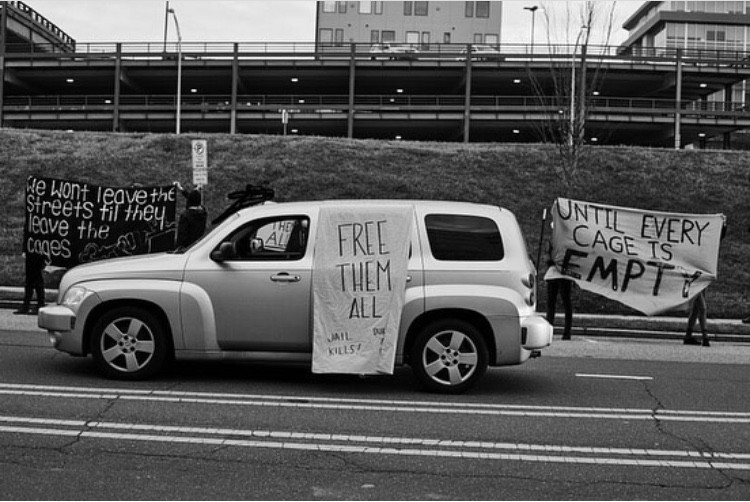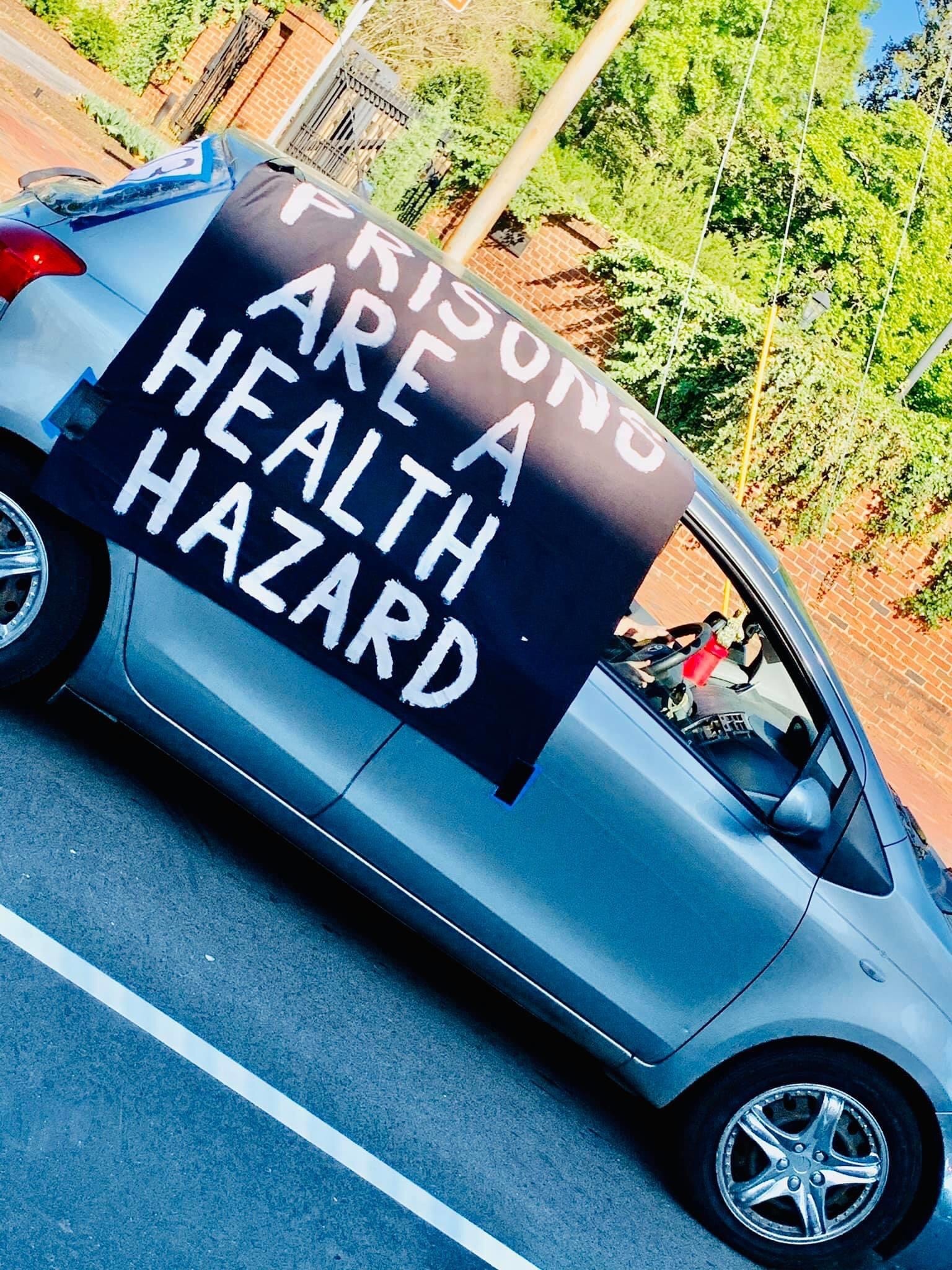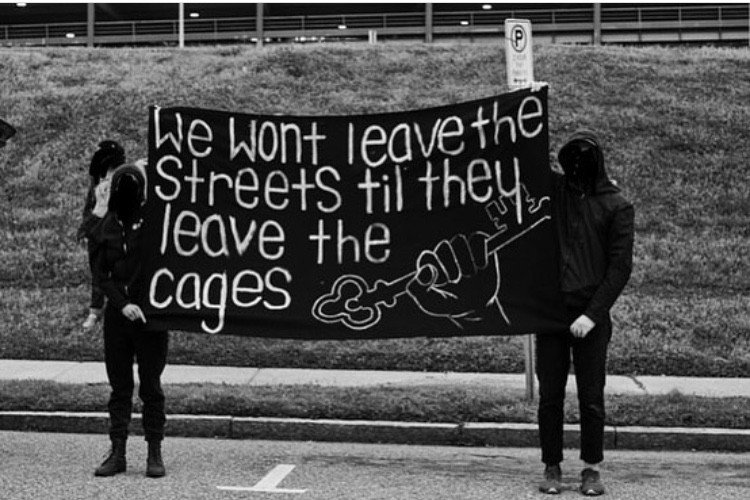Filed under: Action, Analysis, Anarchist Movement, Featured, Incarceration, Police, Southeast, White Supremacy

Reportbacks from two different demonstrations pushing for the release of prisoners on the local and state-level, as well as some thoughts on experimentation and repression with the car demo as a tactic.
Twice in the last several weeks, radicals, anarchists, and abolitionists took advantage of the new tactic of the car demo in central NC to put pressure on county and statewide governments to release prisoners in the face of the coronavirus. The unprecedented danger that this pandemic represents for those on the inside has become more clear every day; as of right now a federal prison in Butner, NC currently has the highest rate of cases in any prison in the country, and we are constantly hearing news from inside state prisons about the disastrous conditions which NC prisoners are facing.
❤️to everyone who came out yesterday to beep their horns & blast their radios at the Governor's Mansion. Leanin out cars to wave flags & singalong to shared tunes was a heartwarming moment in shitty times. #CareNotCages & #Fuck12 @StrawFinal @NCResists @united4survival pic.twitter.com/DFlAK2WBBZ
— Empty Cages Collective (@EmptyCagesColl) April 11, 2020
These demos built upon petitions and phone zaps drafted and spread by anti-prison groups like the Empty Cages Collective, a tremendous amount of networking and correspondence with those on the inside, as well as other, more center-left coalitions that are calling for a range of liberal reform, including some releases from jails and prisons.
Durham, March 26th
When the jail demo was announced, rumors of shelter-in-place orders were swirling around, but none had come down on the state level. The City of Durham, critical of the governor for taking too long, joined some other local governments in issuing their own, set to go into effect at 6:00 pm on the day of the demo, which began at 6:30 pm.
The Durham demo had multiple components and possibilities for participating, including a day-long push on an ongoing call in campaign to the Sheriff and DA, participation in cars, or safe distance participation outside. The decision to keep the demo at its scheduled time and date took into account research and an understanding of the orders and their potential relevance to protest. It was also made with a deep desire to meet this confusing moment of social restriction with a strong continued show of support for people in the jail. Continuing with the demo was also meant to offer reassurance to whoever would come that evening that togetherness and solidarity in many forms belong to us, and will and must persist creatively as state control tightens.
The demo at the #DurhamJail last night was awesome! So heartwarming to see folks inside banging their windows along with the noise. https://t.co/cBkcqGyEgQ
— Empty Cages Collective (@EmptyCagesColl) March 27, 2020
An experimental and caring energy dominated the mood of the crowd, who found different ways to communicate and new ways to move through space around the jail, a place where family, friends and community members and projects have demonstrated for a decade. The intensity of our times and the demand of freeing people while there is still time to save lives was clear in the emotions of people in the crowd, and of people inside.
After a beautiful and loud caravan of cars and people with banners and masks circled the entire jail and courthouse complex on arterial city streets, marching by the back parking lot as detention officers changed shifts, a line of cars sat in the street honking and waving signs facing a long wall of cell windows. Standing in the street, with strong gusts of spring wind racing down the side street, we could hear the pounding on the walls and windows inside everywhere, so loud that it could be heard over the blaring of horns and chants and shouting. Like in other places, the messages people held up inside were simple, urgent, heartbreaking: Free Us.
New points of collaboration between many people working on different projects and campaigns demanding release for people in jails, prisons and ICE detention feels like one of the things that grew out of this day of action against the Durham jail. It is critical and irreplaceable for people inside to see us, hear from us, know that we are making calls, and that they are not forgotten as we all fight the pandemic and as we continue already urgent fights against prisons and for abolition. The first experience in our area of the car demo tactic was also something that generated discussions and ideas about new challenges and new possibilities.
Raleigh, April 10th
A couple weeks later, folks sought to utilize a similar approach to amplify pressure on the statewide level. Along with similar calls for “decarceration” across the country, the second demo sought to surround the governor’s mansion in downtown Raleigh. This was the same building at which a crowd of angry anti-police demonstrators tore down and burned flags less than a month ago, in response to the police shooting of Javier Torres (https://wlos.com/news/local/police-shooting-leads-to-tension-protests-in-raleigh-overnight).
Even more cars showed up this time than the Durham demo, and the growing caravan took up two lanes of traffic as it slowly made its way around the brick-walled “mansion”. Banners reading “Care Not Cages” and “Prisons Are a Health Hazard” were draped along the sides of cars. Others waved flags and leaned out their windows, singing in unison to the tunes of “Free Radio Covidia 90.3,” a mobile pirate radio station set up for just this occasion and advertised with “90.3” signs on the outside of cars. The dance tunes of an anti-prison themed playlist mingled with an absolute cacophony of horns.
After a couple loops around the building, the appearance of police in the rearview mirror accompanied a pile of pallets left at Governor Cooper’s gate, along with a banner that read something like “hospitals not prisons.” Unfortunately, at that moment a cop approached a stopped truck, grabbed the driver by the neck, and yanked him out of his car. Police SUVs soon blocked off two of the four streets bordering the governor’s mansion, making the caravan mostly impossible. With no physical crowd to reassemble and draft a new plan, the caravan’s dispersal was a mess, with cars trying to find each other awkwardly around downtown for the next 30 minutes before moving to the jail. In Durham, we had the luxury of individuals meandering outside of their vehicles casually from car to car, passing along messages and remaining cohesive; in Raleigh we did not.
The police response only heightened later on as a dozen or so comrades waited with banners on the lawn of the jail. Police quoted social distancing guidelines as an excuse to constantly threaten us with arrest for “protesting,” even as we were appropriately distanced and wearing masks. Ultimately, our comrade was released, but not before a line of glove-wearing cops carrying pepper spray marched down supporters on the lawn, scattering us to the parking garage and tailing our cars throughout the surrounding area for over two hours.
Some Thoughts on the Car Demo as a Tactic
New times always result in new tactics, and the context of stay-at-home orders and #socialdistancing is no different. The car demo has emerged as a clever way to observe these rules while establishing a kind of distanced collectivity. This tactic offers a way to be loud, impede roadways in a quasi-legal manner, and publicly protest during a time in which people are desperate for togetherness. We are eager to render political a crisis that we have been forced to experience privately and silently; we are tired of feeling scared and alone.
What are ways to push the boundaries of this tactic? The mobile pirate radio station in Raleigh was one—it coordinated the noise coming out of each car’s stereo, and could with some adaptation be used with a live mic to coordinate last-minute changes in route and perhaps organize a more cohesive dispersal and re-gathering. Radio is also a refreshingly analog form of tech in a time when everyone is getting pretty sick of texting apps and zoom meetings.
Location could be another site for experimentation. Demonstration caravans could proceed at a snail’s pace along important interstates to disrupt economic infrastructure, only to speed up when need be. Perhaps a less traceable car could “break down” and become a barricade to be left behind. Likewise, some car demos organized to support rent strikes have had a less conflictual tone and instead spread their message as “parades” through sympathetic neighborhoods. All of this, of course, requires access to vehicles—this tactic seems less relevant, for example, for denser cities where far fewer folks own cars.
New tactics also mean new forms of repression. A car is easy to identify, follow, and trace to a real live human being, and a bunch of us absolutely had our license plates taken down. In Chicago, the Sheriff’s Department retaliated against a recent car demo by showing up the following day to the home of a high-profile abolitionist, who they then arrested on a two-year old warrant from a claim of unpaid traffic violations. In Raleigh, one participant was ticketed for running a red light, directly due to their participation.
Specifically, assault charges that occur when a vehicle is involved can sometimes be amplified to carry a “deadly weapon” element, depending on local ordinance. Our comrade is currently facing a felony on a similar charge. On top of this, it is a safe bet that the state will lean on new powers guaranteed by emergency declarations and stay-at-home orders to further criminalize this tactic as it becomes more popular and effective.
Regardless, we will continue to experiment and build the pressure. Friends, family, and comrades behind bars are facing a mass catastrophe, and we can do no less.
Until Every Cage is Empty,
Some anarchists








